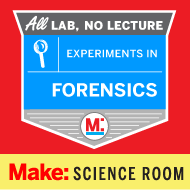This article incorporates, in modified form, material from the not-yet-published Illustrated Guide to Forensics Investigations: Uncover Evidence in Your Home, Lab, or Basement.
The cuticle is made up of overlapping plates or scales of keratin arrayed in characteristic patterns. Although these scale patterns may be visible on a wet-mounted specimen at high magnification, it is often difficult or impossible to discern the scale pattern if the refractive index of the scales is very close to that of the mounting fluid. One way around this problem is to make a cast of the exterior surface of the hair and examine that cast under high magnification.
Figure 6-7 shows the three major types of scale patterns. The imbricate scale pattern is a flattened wavy pattern that is commonly found on human hair and many types of animal hair. The coronal scale pattern is a crown-like pattern that resembles a stack of paper cups, and is normally found only on very fine hair. Coronal scales are found on many types of animal hair and are very rarely present on human hair. The spinous scale pattern is a petal-like pattern made up of triangular scales that protrude from the cuticle. Spinous scales are found in the proximal (root) region of the fur hair of some animals, including bobcat, chinchilla, fox, lynx, mink, mouse, otter, raccoon, rat, sable, sable, seal, and sea lion. Spinous scales are never found in human hair.
Figure 6-7. Imbricate, coronal, and spinous scale patterns (left to right)
Although scale patterns are seldom useful for characterizing human hair specimens, they are important for discriminating human hair from animal hair and for determining the type of animal from which a specimen originated. For much more information about scale patterns, read Microscopy of Hair Part II: A Practical Guide and Manual for Animal Hairs, Forensic Science Communications, July 2004, Volume 6, Number 3.
In this lab session, we’ll make scale casts using ordinary colorless nail polish as a casting medium, the same method used by professional forensics labs.
Required Equipment and Supplies
- goggles, gloves, and protective clothing
- compound microscope
- forceps or tweezers
- microscope slides (as required)
- nail polish (colorless)
- nail polish remover or acetone
- human hair specimens
All of the specialty lab equipment and chemicals needed for this and other lab sessions are available individually from the Maker Shed or other laboratory supplies vendors. Maker Shed also offers customized laboratory kits at special prices, and a wide selection of microscopes and microscope accessories.
 CAUTIONS
CAUTIONS
Although none of the activities in this lab present any significant risks, as a matter of good practice you should always wear splash goggles, gloves, and protective clothing when working in the lab, if only to avoid contaminating specimens. Obviously, you may need to work without goggles when using a microscope or magnifier to examine specimens.
Procedure
- Brush a thin layer of clear nail polish onto the middle third of a microscope slide.
- Carefully press the hair specimen into the tacky nail polish until it adheres.
- Allow the nail polish to dry.
- Using the forceps, carefully pull the hair specimen away from the slide in one smooth motion.
- Examine the scale cast under high magnification by both transmitted and incident light, adjusting the brightness, angle, and contrast of the lighting to optimize visibility of the scale pattern. Use your ocular micrometer to measure the size of the scales, and note any variations in the pattern or size of the scales over the length of the shaft. Record your observations in your lab notebook or in Table 6-4.
- Repeat steps 1 through 5 for each of your hair specimens.
- If you have the necessary equipment, shoot an image of a representative scale pattern for your lab notebook. Otherwise, make a sketch and paste it into your notebook.
Figure 6-8. Using forceps to remove the hair specimen from the dried nail polish
Scale casts may last for several days to several months, depending on how they are stored. High temperature and high humidity reduce the useful lifetime of such casts. When you are finished using a cast, you can use nail polish remover or acetone to clean the nail polish from the slide.
Table 6-4. Make Scale Casts of Hair specimens – observed data
| # | Observations |
|---|---|
| 1 | |
| 2 | |
| 3 | |
| 4 | |
| 5 | |
| 6 | |
| 7 | |
| 8 | |
| 9 | |
| 10 |
Review Questions
Q1: The presence of which of the three scale patterns rules out a hair specimen as human?
Q2: What is the primary forensic value of determining the scale pattern on a hair specimen?









Once I originally commented I clicked the -Notify me when new feedback are added- checkbox and now each time a comment is added I get 4 emails with the same comment. Is there any means you can remove me from that service? Thanks!